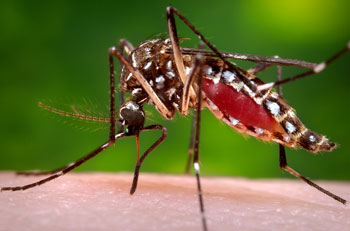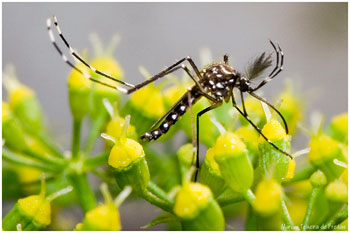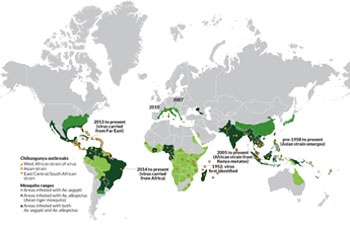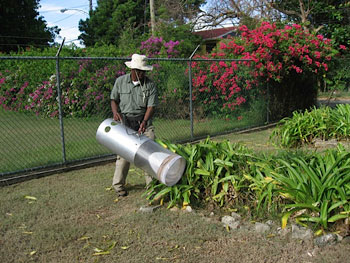Chikungunya wings its way north — on mosquitoes
A crippling computer virus has escaped Africa and Asia. Now it's invading other continents faster than people sack learn to pronounce its identify. The computer virus, carried away mosquitoes, causes chikungunya (Chihk-uhn-GUHN-yuh) febrility. And in just 10 years, it has gone from an obscure tropical disease to a worldwide threat. So farther it has caused more 3 million infections around the globe. The computer virus recently took root in Latin America. Information technology may now be fit to visit wretchedness in cooler climates, including North America.
Chikungunya seldom kills its victims. But information technology crapper bring a world of weakened. Information technology begins like the flu — fever, chills, headache, aching joints. And IT typically lingers for a hebdomad. But for many people, that is far from the end of it. Over time, severe joint pain can emerge. And that pain nates loiter for months — even age. The virus causes many of its victims to have a stooped posture. So, in a social group language of Eastside Africa, chikungunya means "to walk bent over" operating theatre "to become contorted."
The mosquito-borne computer virus has ventured from its home in Africa respective times. It inhabited into South Asia in the 1950s. But nigh of its other attempts to escape Africa fizzled.

Not this time. In 2005, chikungunya left Kenya. It hit some islands in the Indian Ocean. Then it spread like a brush firing through India and Southeast Asia. In 2013, the type — or strain — of chikungunya that had been devising people fed up in Asia since the 1950s suddenly found its way to the Caribbean. IT reached Florida in 2014.
It's not the first time a tropical disease has reached other warm regions. But usually so much diseases don't spread to ice chest regions outside the tropics, called temperate zones. Now, one strain of the chikungunya virus has institute a way to live on in mosquitoes that live in those tank zones. That allowed it to recently spread into Italy and French Republic. North America, China and Europe could be next.
So chikungunya could be coming to a mosquito approximate you. No one knows whether the computer virus will be healthy to become deeply rooted in temperate zones. But U.S. outbreaks are a historical possibility, says Stephen Higgs. Atomic number 2's a chikungunya expert at Kansa State University in Manhattan.
Island hopping
The asleep island of Réunion is a French territory in a remote set forth of the Indian Ocean. It sits off of the southeast seashore of Africa. This would appear like an nonpareil place to avoid spherical health problems.But in 2005 and 2006, chikungunya arrived there from the mainland.
The disease devastated Réunion. Some 266,000 of the island's roughly 800,000 citizenry were struck. At the height of the outbreak, 40,000 patients a week streamed into clinics there. The computer virus also blew through other islands in the region. When it got to India in late 2005, chikungunya luck out — fold to 1.4 million infections. From India it spawned outbreaks across Southeast Asia.
This explosion of infections stunned global health experts. Something had changed.
Réunion seemed an odd stopover for the computer virus. That's because the island had few if any Aedes aegypti (AY-dees Eh-JIP-tye) mosquitoes. These are the tropical mosquitoes that typically carry the virus around Africa and Asia. But as in numerous cooler parts of the world, another type of mosquito swarms across Réunion: Aedes albopictus (AL-boh-PIK-tus). It many another places, this black-and-white-striped blood sucker is known atomic number 3 the Asian tiger mosquito.

And as researchers soon learned, the African chikungunya virus could now thrive inwardly this new mosquito because the genes inside this seed had changed, or mutated .
When a mosquito takes a blood repast from a person carrying chikungunya, the virus quickly makes many copies of itself in the insect's gut. That treat is called retort. The newly formed viruses then visit the mosquito's saliva. As a result, the insect's next bit is like a hypodermic acerate leaf loaded with virus.
Until the virus mutated, tiger mosquitoes couldn't spread chikungunya very well. But the new genetic mutation made it about 100 times easier for the virus to survive inside the Panthera tigris mosquito's innards long enough to retroflex. The next time that mosquito bit someone, itimmediately could shed some of the virus to its victim.
Blue jets bound for ice chest climates sometimes took off with passengers who had been bitten aside Panthera tigris mosquito. It should come as no surprisal, then, that within a few years some infected visitors brought chikungunya with them to Italy and France. Italy reported about 200 infections in 2007.
That's not a very big number. Still, information technology showed that chikungunya could with success venture outside the tropics. "That was a game auto-changer," says Scott Weaver. He's a virus skilled, Beaver State virologist, at the University of Texas Medical Branch in Galveston.
Westward ho!
A second storm came in 2013 when chikungunya showed raised on the sun-distributed Caribbean island of Saint Martin. It lies about 2,000 kilometers (1,242 miles) southeast of Miami. A traveler arrived there carrying the virus. Scientists believe this infected visitant arrived from Asia. On the island of Nonesuch Martin, this traveler was then bitten away a local mosquito.

That glitch moldiness give picked up the computer virus, copied it, and and so spread those copies when it spot other people, says Ann Powers. She's a molecular virologist at the Centers for Disease Control and Bar in Fort Collins, Colo. (Molecular virologists study the tiny structures that make leading viruses, including viral genes and the proteins they are responsible for making.) This infection launched an epiphytotic in the New World.
Clear, Weaver says, "Our luck ran out." In the next year and a half, chikungunya found a foothold in the Americas. And it may ne'er leave. Florida had 11 cases in 2014. All were transmitted aside local mosquitoes. The warm states bordering the Golfo de Mexico also may be at endangerment. The conclude? Genus Aedes aegypti, the tropical mosquito that appears to be driving the pestiferous, can resilient there, explains Higgs at Kansas State. He adds that the cause the Caribbean infections haven't spread further into North America is because those mosquitoes can't survive in the colder states.
Simply the Panthera tigris mosquito can. If a giddy traveler were to fetch chikungunya to Europe or the eastern Agreed States, the disease would non spread — unless the traveller was carrying a strain of the virus modified to the Panthera tigris mosquito.
Meanwhile, Aedes aegypti is spreading the Asian sift of chikungunya in Latin America and the Caribbean Sea. Tens of thousands of cases have been confirmed. Much 1 million people are suspected of having become infected. This epidemic has stretched to Brazil in the northernmost part of South America. There, the virus has spread the disease from person to mosquito to person — hundreds of times.
Much of Brazil nut is home to some the tiger mosquito and Aedes aegypti. Scientists now are trying to determine which worm is dispersive the virus there. Brazil has a secondment problem. It has cases of both strains of chikungunya — the Asian strain that swept the Caribbean and the African strain that learned to ride the tiger mosquito in the Indian Sea.
Researchers don't know yet if the African strain has mutated in Brazil as it did in Réunion.
If the computer virus in Brazil does mutate, the West could present a worst-case scenario. That's because Panama, Mexico and many past countries also have both mosquitoes. The jeopardy posed by having a version of chikungunya in the West that has adapted to cooler-geographical zone mosquitoes keeps U.S. infectious disease experts up at nighttime.
"It's certainly something I worry about," says Mark Heise. He's a virologist — a scientist who studies viruses — at the University of North Carolina at Chapel Hill.
Oh, the pain
People rarely get chikungunya twice. Simply once is bad plenty.
The CDC's Ann Powers first gear sawing machine people sick with chikungunya in the Comoros. It's a group of islands in the Amerindic Ocean. These islands were hit about the unchanged time as Réunion was. Powers interviewed some patients as they lay fine-tune. Their ankles were so inflamed they couldn't stand. "Quivering custody hurt them," she says. "It was unimagined to see people therein much pain," she says.
Explainer: What is a virus?
One long-term program monitored 102 patients in Réunion. It found that threesome old age after beingness infected with the chikungunya virus, 60 percent still reported united pain. A French team reportable those findings in the technological journal PLOS Neglected Tropical Diseases in 2013. In Italy, nearly 67 percent of patients continued to have pain a year after first proper infected.
The unhealthful joint symptoms can disable a whole community, says Saint David Morens. He works at the National Institute of Allergy and Infectious Diseases in Bethesda, Md. He specializes in perusal viruses and other germs that feign children. "In Asia,you ascertain these really massive outbreaks where everybody gets sick at once." In front long, he notes, "There are no taxicabs, nary teachers." Everyone seems to possess gotten sick.
Meaningful women chee special risks. Of 39 pregnant women in Réunion World Health Organization had chikungunya fever around the time they were about to contribute birth, 19 had infected newborns. And 10 of those infants developed serious health problems, French researchers reported in 2008.
Treatment options are limited
There are few treatments for chikungunya. Doctors posterior offer drugs to reduce feverishness and provide fluids to circumscribe the risk of dehydration. The drug Virazole, which Chicago some viruses from replicating, too appears to help oneself somewhat.

But unitary of the much promising treatments power come through from the rip of populate who have recovered from chikungunya. When people become infected, their immune systems make proteins called antibodies . These can run and try to the block the virus from infecting new cells. Antibodies from patients who hold recovered mightiness do the same matter in people still sick with the disease. Merely premiere, more testing is requisite.
One 2013 study used mice. It found antibodies from mice that survived the disease could deflect chikungunya computer virus from infecting spick-and-span animals. The antibodies flush worked when injected after the virus had infected mice — as tall as they did not yet show symptoms, says Heise at the University of North Carolina. His team authored the report, publicized in PLOS Pathogens.
Researchers also think it might be assertable to stop chikungunya by using the body's natural immune answer against it. They'd do this with a vaccinum. Several research teams suffer reported promising results from vaccines that use chikungunya proteins. These viral bits kick-start the production of antibodies that can block infection.
In one study, a vaccine successful from the virus's own proteins gave multitude protection for at least 44 weeks. That study was led by Julie Ledgerwood. She's a vaccinum researcher at the National Institute of Allergy and Health problem Diseases in Bethesda, Doctor of Medicine. Her team reported its results in the December 6, 2014, issue of a medical exam journal, The Lancet.

Vaccines now being tested are likely to protect against completely three major strains of chikungunya, Ledgerwood says. These include the mutated virus carried by the tiger mosquito.
If the chikungunya virus finds ways to survive in temperate regions, like nearly of the United States, infections there could get over an annual summer put on the line, says Powers of the Center for Disease Control and Prevention.
Others doubtfulness chikungunya will linger over in the West. In the past, chikungunya may have escaped Africa every 50 or 60 geezerhood. Each time, it flared awhile and then died out, says Scott Halstead. Atomic number 2's an infectious disease physician at the Clothed Services University of the Health Sciences in Bethesda, Mendelevium. He doubts the computer virus will propagate for good to all parts of the globe.
For the virus to stay in the West, information technology has to either adapt itself to humans or to wild animals, says Morens of the Public Institute of Allergy and Infectious Diseases. If it infects monkeys, chikungunya could linger below the radar for age at a time. Then, directly and again, IT could cross terminated into people. This is what chikungunya — and Ebola — both brawl in Africa.
"The other possibility is more than petrifying," Morens says. "The virus adapts itself to a new cycle, completely human-to-mosquito-to-human." It power evolve in a agency that No longer needs a long-term wild-foxlike host. If that happens, he says, "it's almost ne'er releas to go away."
Word Find(click Hera to enlarge for printing)


Post a Comment for "Chikungunya wings its way north — on mosquitoes"